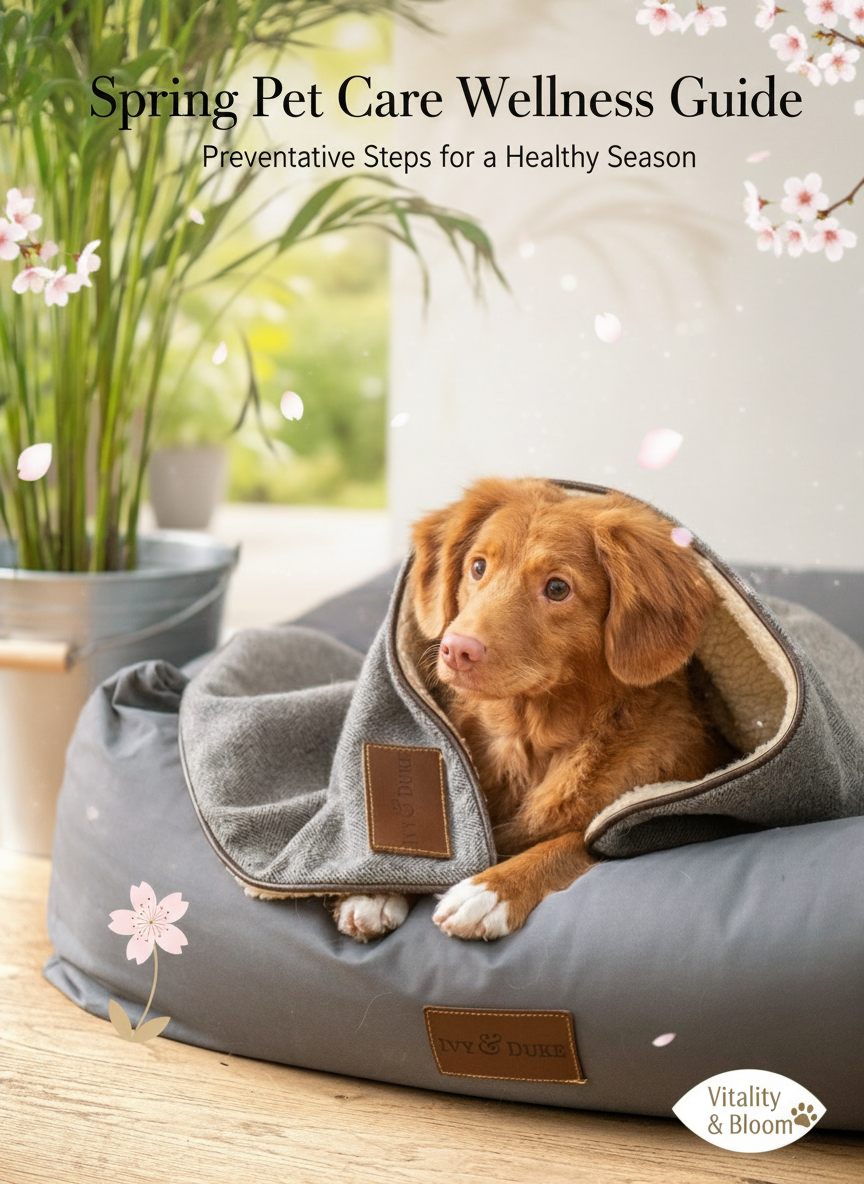Spring is the perfect time to revitalize your pet care routine, addressing seasonal risks like parasites, allergies, and weight changes. This detailed guide will help you protect and nurture your dog or cat through thoughtful preventative wellness and practical steps.
Essential Spring Pet Care Guide: Yearly Preventative Wellness for Dogs and Cats
Key Takeaways
- Spring marks a crucial time to restart parasite prevention and schedule heartworm testing.
- Managing seasonal allergies early improves your pet’s comfort and health.
- Regular grooming and dental care support skin and oral wellness during seasonal changes.
- Keeping vaccinations current and maintaining proper nutrition optimize your pet’s immunity and weight.
- Updating identification and microchip info enhances pet safety during more outdoor adventures.
- Consult your veterinarian before introducing supplements like CBD to ensure safe use.
Table of Contents
- 1. Why Spring Is Critical for Parasite Prevention
- 2. Managing Seasonal Allergies in Pets During Spring
- 3. Grooming and Shedding Control for Spring
- 4. Staying Up to Date with Vaccinations in Spring
- 5. The Importance of Dental Hygiene in Your Pet’s Spring Wellness
- 6. Nutrition and Weight Management for Optimal Pet Health
- 7. The Value of Annual Wellness Exams
- 8. Microchip and Identification: Low-Effort, High-Impact Safety
- 9. Exploring CBD Pet Products Safely
- 10. Seasonal Adjustments and Home Safety Tips
1. Why Spring Is Critical for Parasite Prevention
As temperatures rise in spring, the activity of parasites such as fleas, ticks, and mosquitoes increases significantly. Since these pests can transmit serious diseases like heartworm and Lyme disease, your pet’s exposure outdoors demands diligent preventative care during this season.
Essential Tips for Spring Parasite Protection:
- Restart or continue parasite preventatives promptly. Begin flea, tick, and heartworm treatments ahead of peak season for best results.
- Schedule an annual heartworm test. This test is vital because preventatives typically target larvae, not adult worms.
- Stay vigilant. Though year-round protection is ideal, spring requires extra caution due to increased risks.
Regular veterinary checkups help keep your pet on the right parasite prevention regimen. For detailed advice, visit the petocart
2. Managing Seasonal Allergies in Pets During Spring
Springtime bloom and pollen can trigger allergies in pets that resemble those in people. If untreated, allergies may significantly reduce your pet’s comfort and overall health.
Common Signs of Allergies:
- Persistent scratching or licking
- Sneezing and watery eyes
- Inflamed or irritated skin
- Frequent paw chewing
- Head shaking or restlessness
Allergy-Relief Strategies:
- Wipe down your pet’s coat and paws after outdoor activity to remove allergens.
- Launder bedding and clean toys and collars regularly to reduce pollen and dander buildup.
- Consult your veterinarian if symptoms persist; treatments may include antihistamines, special diets, or allergy testing.
Early allergy management can greatly enhance springtime comfort. For further tips, see the Spring Health Checklist.
3. Grooming and Shedding Control for Spring
As winter coats give way to lighter spring fur, grooming becomes essential to control shedding and maintain your pet’s comfort indoors and out.
Spring Grooming Must-Dos:
- Brush frequently. Regular brushing reduces shedding and prevents mats.
- Bathe periodically. Use mild shampoos to wash away pollen, dirt, and allergens.
- Trim nails. Less winter activity may cause overgrowth, which can impact comfort and joint health.
- Clean pet belongings. Wash blankets, beds, toys, and collars frequently to lower dander and parasite risks.
Grooming is also your chance to spot pests or skin issues early. Find additional guidance on the Spring Health Checklist.
4. Staying Up to Date with Vaccinations in Spring
With increased outdoor interactions in spring, maintaining current vaccinations is crucial for your pet’s protection against contagious diseases.
Vaccination Guidelines:
- Core vaccines such as rabies, distemper, and parvovirus guard against serious illnesses.
- Lifestyle-dependent vaccines like Lyme or leptospirosis may be advised based on your location and pet’s activities.
- Booster shots and annual updates ensure lasting immunity throughout spring and beyond.
Discuss the best vaccination plan with your veterinarian. Learn more at Wellness & Preventive Care Services.
5. The Importance of Dental Hygiene in Your Pet’s Spring Wellness
Dental health is often overlooked but critical — poor oral hygiene can lead to pain and systemic health problems.
Dental Health Checklist:
- Brush your pet’s teeth regularly. Use pet-specific dental products.
- Schedule professional dental cleanings when recommended to remove plaque buildup.
- Watch for warning signs such as bad breath, excessive drooling, sensitivity, or decreased appetite.
A healthy mouth supports your pet’s happiness and longevity. See expert advice at Preventive Care at Bond Vet.
6. Nutrition and Weight Management for Optimal Pet Health
After a less active winter, spring is the ideal time to reassess diet and activity levels to maintain a healthy weight.
Smart Nutrition Tips:
- Review your pet’s diet with your veterinarian to ensure suitability for their age, breed, and health.
- Gradually increase exercise. This helps improve stamina and promotes safe weight loss.
- Track weight weekly. Early detection of trends helps prevent obesity-related diseases.
- Limit treats and table scraps. Human foods can disrupt nutritional balance.
Maintaining a proper weight supports mobility and long-term health. Discover more in the Spring Preparedness Guide.
7. The Value of Annual Wellness Exams
Spring is a practical time to book your pet’s yearly examination, enabling early detection and prevention of health issues.
What’s Included in an Annual Exam:
- Comprehensive physical examination
- Heartworm and parasite screenings
- Vaccination review and updates
- Dental evaluation
- Nutritional and weight assessment
- Behavioral check-ins
- Microchip scanning and ID verification
These visits empower you and your vet to craft a year-round wellness plan. Schedule yours at Redlands Animal Hospital.
8. Microchip and Identification: Low-Effort, High-Impact Safety
With increased outdoor time, ensuring your pet’s identification is current helps ensure a safe return if they get lost.
Identification Safety Reminders:
- Update your microchip information to keep contacts accurate.
- Inspect collars and tags for damage or illegibility; replace as needed.
- Use multiple forms of ID such as a collar tag plus a registered microchip.
Minutes spent today can prevent heartache later. Learn more at Bond Vet’s Preventive Care Services.
9. Exploring CBD Pet Products Safely
CBD products have become popular for pets, often used for stress or joint health, but safety and veterinary guidance are paramount.
Key Considerations for Pet CBD Use:
- Always consult your veterinarian before starting CBD, as dosing varies.
- Choose THC-free, quality-assured products that are lab tested and transparent.
- Use CBD as a supplement, not a replacement for veterinary care or prescribed medicines.
With careful use, CBD can complement your pet’s wellness plan. Explore options at Symphony Vet’s Wellness Services.
10. Seasonal Adjustments and Home Safety Tips
Spring’s energy brings new activities but also unique safety challenges indoors and outdoors.
Spring Safety Checklist:
- Store chemicals, fertilizers, and toxic plants out of your pet’s reach.
- Ensure fresh water is always accessible as temperatures climb.
- Avoid pesticides or herbicides in pet play areas.
- Inspect fences and gates for damage or gaps before outdoor time.
Simple precautions keep your pet safe and happy in every season. For a full safety list, visit Your Spring Pet Care Checklist.
FAQ
How often should I restart parasite preventatives in spring?
Begin or restart parasite preventatives as soon as temperatures consistently exceed 45°F (7°C), typically early spring, to block flea and tick infestations before peak season.
Can pets have seasonal allergies like humans?
Yes, many pets experience reactions to pollen and other allergens during spring, showing signs like itching, sneezing, and irritated skin.
Is CBD safe for all pets?
CBD safety depends on your pet’s species, size, and health condition. Always consult your veterinarian before starting CBD supplements to ensure proper dosing and product choice.
Why is an annual wellness exam important in spring?
An annual exam in spring allows your vet to catch health issues early, update vaccinations, and create a customized care plan for the year ahead, timed before increased outdoor exposure.
How can I control shedding in spring?
Brush your pet regularly to remove loose fur, bathe with gentle shampoos to cleanse pollen and dirt, and maintain grooming routines to minimize shedding indoors.







